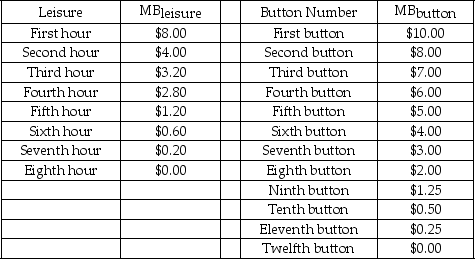Multiple Choice
Scenario: This problem applies the principle of optimization covered in Chapter 5 to the problem of choosing how many hours to work. Paul has to decide how many hours to work per day. His boss is willing to give Paul whatever hours Paul wants up to 8 hours. All else being equal, he would rather not work, that is, Paul has positive marginal benefit from each hour of leisure. But he is an avid collector of presidential campaign buttons. The more leisure he takes, the fewer buttons he can afford. So Paul faces a trade-off between leisure and buttons. Each button costs $1.00. The table below shows Paul's marginal benefits from leisure (MBlₑᵢsᵤᵣₑ) and buttons (MBbᵤttₒn) .

-Refer to the scenario above.If the hourly wage is $1.60,how many hours would Paul choose to work? How many buttons would he buy?
A) 2 hours; 12 buttons
B) 3 hours; 4 buttons
C) 4 hours; 5 buttons
D) 5 hours; 8 buttons
Correct Answer:

Verified
Correct Answer:
Verified
Q105: Which of the following statements is true?<br>A)
Q106: Paul wants to renovate his home and
Q107: How are skilled and unskilled workers in
Q108: If leisure is a normal good,how will
Q109: Other things remaining the same,which of the
Q111: If there is an increase in the
Q112: Ryan and David are two recent high
Q113: The profit-maximizing rule for a competitive firm
Q114: Suppose you are a worker and the
Q115: What is the difference between wage differentials